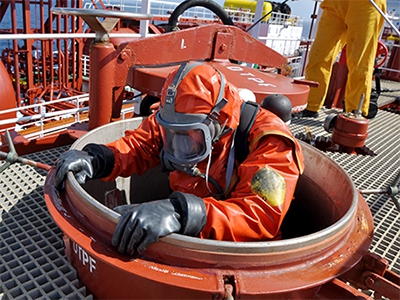Seafarers will be better protected as new UK rules come into force to tighten up safety for those who work in enclosed spaces on board vessels.
The updated legislation goes further than that currently required under international maritime law and is part of the ongoing commitment by the UK to seafarer welfare.
Enclosed spaces include chain lockers, cargo holds, duct keels and water tanks or any area that has been left closed for any length of time without ventilation.
Six people have died over a ten-year period from 2009 to 2019 in UK ports while working in such spaces, which has led to this legislation being introduced.
Although carrying out assignments in enclosed spaces is a necessary part of working on ships, the MCA is committed to reducing the risks and will continue to review how best to protect people in those environments
said MCA.
The changes will replace previous legislation, requiring ships to protect workers from the risks of entry into enclosed spaces through measures such as regular safety drills and providing atmosphere testing equipment.
Considering the serious risk to seafarers’ health and safety, the Maritime and Coastguard Agency has also extended the new measures to a wider range of vessels than just those covered by the International Convention for the Safety of Life at Sea (SOLAS). Fishing vessels will now also be required to put in place safe systems of work for enclosed space entry.
The regulations come into force for vessels which come under SOLAS on 14 May 2022 while for all others it will apply from 14 May 2023. The dates have been chosen to give the ships for which the regulations are new the time to become compliant.
Katy Ware, Director of Maritime Services, commented:
We remain committed to protecting the safety of those who spend their lives working at sea. There is a serious risk to seafarers’ health and safety by going into these enclosed spaces, even though it is sometimes a necessary part of their work and we want to do all we can to reduce the risks
She also added that the risks from working in enclosed spaces are well known across the shipping world and “all of us know that more needs to be done to reduce the number of fatalities. These regulations will replace and extend current legislation which will go right across the merchant sector.
Training and awareness
All seafarers should have on-board training to help recognise the risks of enclosed spaces and to familiarise themselves with any applicable procedures. No entry into an enclosed space should be permitted until suitably qualified persons are present. The implications of this should be considered in particular when the competent person and/or authorised officer are shore-based personnel.
The shipowner or company should also provide any necessary training, instruction and information to seafarers to allow the 2022 regulations to be complied with. This should include:
- Recognition of the circumstances and activities likely to lead to the presence of a dangerous atmosphere;
- The hazards associated with entry into enclosed spaces, and the precautions to be taken;
- The use and maintenance of equipment and clothing required for entry into enclosed spaces;
- Instruction and drills in rescue from enclosed spaces.
Entrances to enclosed spaces
The master of a ship must ensure that all entrances to unattended enclosed spaces on the vessel are either kept closed or otherwise secured against entry, except when entry is necessary.
In addition, there should be safety signage advising of potential hazardous atmospheres, even in areas which are kept closed or locked and when procedures prohibit entry to the enclosed space.
Entrances could include doors, hatches or manholes. It is important to remember that an enclosed space can still be accessed, even if secured. In the case of the ERRV Viking Islay, the space was secured but seafarers accessed the space. In this case, awareness of the risks and appropriate procedures for entry to enclosed spaces could have saved lives.
Risk Assessment of an Enclosed Space
An authorised officer or competent person should follow company procedures to assess the risks of enclosed spaces. Based on the findings of the risk assessment appropriate control measures should be put in place to protect anyone who may enter an enclosed space.
A risk assessment should not be limited only to entry into the enclosed space but also consider the environment and activity as a whole and any other potential safety hazards, including but not limited to low lighting and reduced visibility, trip hazards, low ceilings and narrow walkways. Any activity which may cause a change in atmosphere such as hot work and use of paints, glues and coatings poses a particular risk.
Consideration should also be given to the ship design and layout as places frequently visited by seafarers can still develop a hazardous environment.
Considerations
- Tests should be taken at varying levels and locations within deep tanks or large spaces. Some gases and vapours are heavier than air and therefore settle at the bottom of an enclosed space, some are lighter than air and so collect at the top of the enclosed space.
- Testing must be for all the gases as outlined within 9.2 above, not just oxygen content, and should also consider other relevant gases.
- Atmospheres can change and therefore regular testing should be undertaken throughout entry.
- Only testing can establish the air environment for what cannot be seen, tasted or smelt.






























































